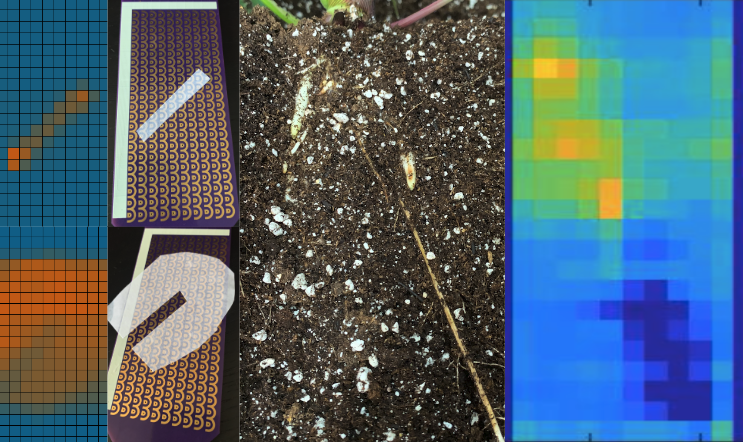Having previously developed algorithms to detect plant root growth using an electrical impedance sensing technology called the RootTracker, the original version arranged electrodes in a circular pattern around a plant. While effective, the circular design presented challenges for scalable manufacturing and installation. To improve scalability, I developed a new Single Paddle RootTracker which increased the spatial electrode resolution by 10x with a new grid sensing technique.
The Technology
The Single Paddle RootTracker consists of a single printed circuit board with gold-plated electrodes arranged in a grid pattern. This simplified design reduced materials and labor costs. However, the grid pattern also required a new sensing approach. Rather than connecting each electrode to a separate pin on a microcontroller, rows and columns are charged and measured sequentially. This allows for a high density of electrodes using fewer microcontroller pins.
Decoding Grid Sensing Data
Extracting root growth signals from the raw voltage measurements now involved new data processing techniques:

- Electrical grid circuit modeling – Voltages are used to calculate the 2D resistance and capacitance maps by modeling and then solving the matrix of differential equations.
- Noise normalization – Capturing the average magnitude of sensor activity in the first few days of an experiment prior to any possible root interactions helps characterize inherent electrical noise of the local soil structure due to local heterogeneity and daily patterns in the variation of soil moisture. This data can then be used to normalize subsequent signals.
- Image analysis – 2D maps allow for leveraging image processing to highlight anomalous signals.

Results
Preliminary experiments and extraction of ground truth root locations demonstrated promising initial validation of the technology. This grid sensing technology not only paves the way for more scalable manufacturing and installation, its form-factor allows for easier ground truth techniques, and serves as a test bed of validation for future form-factors.

